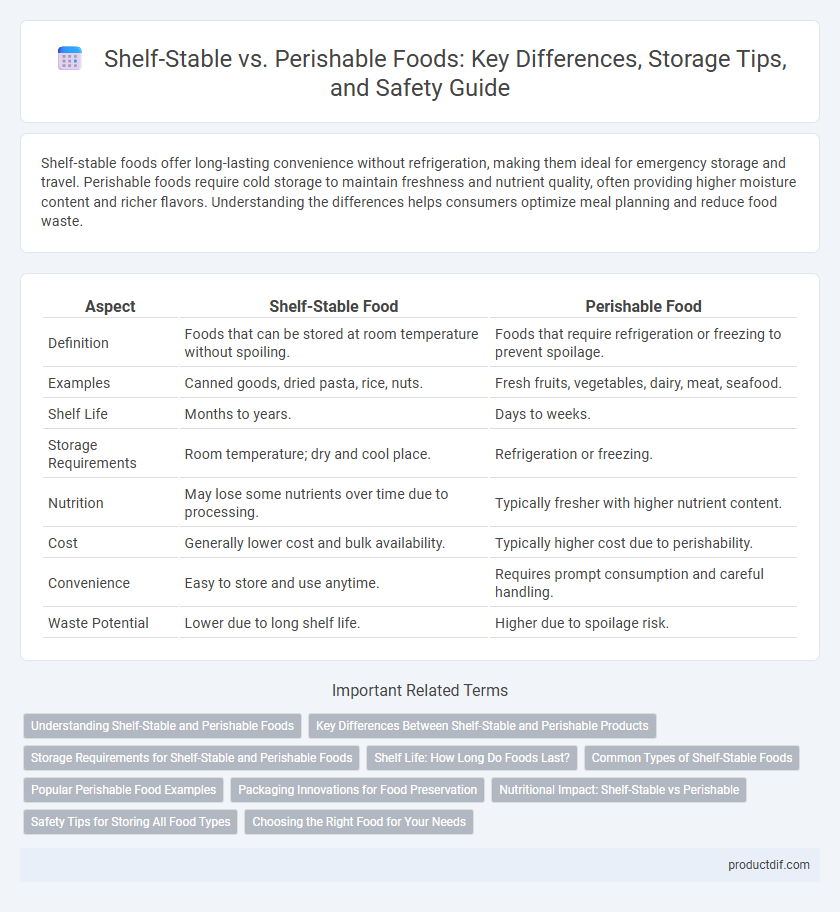Shelf-stable foods offer long-lasting convenience without refrigeration, making them ideal for emergency storage and travel. Perishable foods require cold storage to maintain freshness and nutrient quality, often providing higher moisture content and richer flavors. Understanding the differences helps consumers optimize meal planning and reduce food waste.
Table of Comparison
| Aspect | Shelf-Stable Food | Perishable Food |
|---|---|---|
| Definition | Foods that can be stored at room temperature without spoiling. | Foods that require refrigeration or freezing to prevent spoilage. |
| Examples | Canned goods, dried pasta, rice, nuts. | Fresh fruits, vegetables, dairy, meat, seafood. |
| Shelf Life | Months to years. | Days to weeks. |
| Storage Requirements | Room temperature; dry and cool place. | Refrigeration or freezing. |
| Nutrition | May lose some nutrients over time due to processing. | Typically fresher with higher nutrient content. |
| Cost | Generally lower cost and bulk availability. | Typically higher cost due to perishability. |
| Convenience | Easy to store and use anytime. | Requires prompt consumption and careful handling. |
| Waste Potential | Lower due to long shelf life. | Higher due to spoilage risk. |
Understanding Shelf-Stable and Perishable Foods
Shelf-stable foods, such as canned vegetables, dried grains, and sealed snacks, are designed to withstand room temperature storage without spoiling for extended periods, thanks to processes like dehydration, sterilization, and vacuum sealing. Perishable foods include fresh produce, dairy, meat, and seafood, which require refrigeration or freezing to maintain freshness and prevent bacterial growth. Understanding the differences between shelf-stable and perishable foods is essential for proper food storage, minimizing waste, and ensuring food safety.
Key Differences Between Shelf-Stable and Perishable Products
Shelf-stable products, such as canned goods and dried pasta, are designed to remain safe and edible at room temperature for extended periods due to preservation methods like dehydration or sterilization. Perishable products, including fresh fruits, dairy, and meats, require refrigeration or freezing to slow microbial growth and enzymatic activity, ensuring they maintain quality and safety. Understanding these distinctions helps optimize storage conditions, reduce food waste, and maintain nutritional value.
Storage Requirements for Shelf-Stable and Perishable Foods
Shelf-stable foods require minimal storage conditions, typically kept at room temperature without refrigeration, making them ideal for long-term storage and emergency preparedness. Perishable foods demand strict temperature control, usually refrigeration or freezing, to prevent spoilage and bacterial growth, ensuring safety and freshness. Understanding these storage requirements helps optimize food safety, reduce waste, and manage household or commercial pantry inventory efficiently.
Shelf Life: How Long Do Foods Last?
Shelf-stable foods such as canned beans, dried pasta, and rice typically have a shelf life ranging from one to five years when stored properly, making them ideal for long-term storage and emergency preparedness. Perishable foods like dairy, fresh fruits, vegetables, and meats usually last only a few days to a couple of weeks under refrigeration due to their high moisture content and susceptibility to microbial growth. Understanding the difference in shelf life between shelf-stable and perishable foods is crucial for meal planning and reducing food waste.
Common Types of Shelf-Stable Foods
Common types of shelf-stable foods include canned vegetables, dried grains such as rice and pasta, and dehydrated fruits. These items are processed or packaged to resist spoilage and can remain edible for months or even years without refrigeration. Staple shelf-stable foods also encompass boxed cereals, powdered milk, and sealed snacks like nuts and crackers, making them essential for long-term food storage.
Popular Perishable Food Examples
Popular perishable foods include fresh fruits like strawberries and apples, dairy products such as milk and cheese, and meats including chicken and beef, all of which require refrigeration to maintain freshness and prevent spoilage. Vegetables like leafy greens, tomatoes, and cucumbers also fall under perishable items due to their high moisture content and sensitivity to temperature changes. These perishable foods have a short shelf life compared to shelf-stable items but offer higher nutritional value and taste when consumed fresh.
Packaging Innovations for Food Preservation
Advanced vacuum-sealed and modified atmosphere packaging (MAP) technologies significantly extend shelf-stable food products' longevity by reducing oxygen exposure and microbial growth. Biodegradable active packaging infused with natural preservatives such as essential oils enhances perishable food preservation by slowing spoilage and maintaining freshness. Smart packaging equipped with time-temperature indicators and freshness sensors provides real-time quality monitoring, ensuring optimal food safety and reducing waste for both shelf-stable and perishable goods.
Nutritional Impact: Shelf-Stable vs Perishable
Shelf-stable foods often retain most nutrients due to advanced preservation methods like canning and dehydration, but some vitamins such as C and B complex degrade over time. Perishable foods generally offer higher fresh nutrient content, including antioxidants and enzymes, which can diminish rapidly after harvest or slaughter. Choosing between shelf-stable and perishable foods impacts dietary intake of sensitive nutrients, crucial for planning balanced meals and maintaining optimal health.
Safety Tips for Storing All Food Types
Store shelf-stable foods in a cool, dry place away from direct sunlight to prevent spoilage and contamination. Perishable items require refrigeration at temperatures below 40degF (4degC) to inhibit bacterial growth and extend freshness. Always separate raw and cooked foods to avoid cross-contamination and use airtight containers to maintain food safety.
Choosing the Right Food for Your Needs
Shelf-stable foods such as canned goods, dried grains, and packaged snacks offer long-term storage without refrigeration, making them ideal for emergencies and convenience. Perishable items like fresh fruits, vegetables, dairy, and meats provide higher nutritional value and flavor but require proper refrigeration and quick consumption. Selecting between shelf-stable and perishable foods depends on factors such as storage capacity, dietary needs, and meal planning preferences.
Shelf-Stable vs Perishable Infographic

 productdif.com
productdif.com